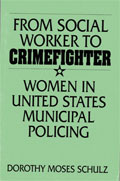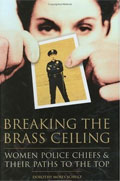
1973 MA John Jay College of Criminal Justice (Criminal Justice)
1966 BA New York University (Journalism)
Dr. Schulz, a retired captain with the Metro-North Commuter Railroad Police Department and its predecessor, Conrail, was the first woman captain in either department. She grew up and attended public schools in upper Manhattan’s Washington Heights. Dr. Schulz researched and wrote From Social Worker to Crimefighter: Women in United States Municipal Policing as part of her doctoral studies at New York University. Published by Praeger in 1995, it focuses on the introduction of women into policing and describes how modern women were forced to reject their earlier roles for a wider presence in law enforcement. Continuing her research into women in policing, she wrote Breaking the Brass Ceiling: Women Police Chiefs and Their Paths to the Top (Praeger, 2004). This book, based on questionnaires and interviews, describes the careers of current chiefs and sheriffs and relates the history of the few women who served early in twentieth century. With Kimberly Hassell and Carol A. Archbold, she edited Women and Policing in America; Classic and Contemporary Readings (Aspen Publishers, 2011). She was editor of the federal volume of the Encyclopedia of Law Enforcement (Sage, 2004), a three-volume police reference work. Dr. Schulz’ research has been funded by government, academic and police groups. She is active in both the railroad and transit sections of the International Association of Chiefs of Police (IACP) and has worked with the Federal Transit Administration (U.S. Department of Transportation) on developing procedures and guidelines for security for new rail systems and for those extending their existing transit systems. She has also worked with the FTA to develop audit procedures for transit agencies and on updating policies for threat assessments and safety and security management. Dr. Schulz has written on issues in transit policing, including most recently, with Susan Gilbert, Video Surveillance Uses by Rail Transit Agencies, a synthesis report funded and published in 2011by the Transportation Research Board. Also in 2011, she contributed two chapters on transportation terrorism to The Counterterrorism Handbook: Tactics, Procedures, and Techniques, 4th ed. (CRC Press) by Frank Bloz, Jr., Kenneth J. Dudonis, and David P. Schulz. She is active in women’s police associations and has been a featured speaker at many policing conferences. She teaches undergraduate and graduate courses, including Women in Policing, Women in the Uniformed Services, History of Police Administration, Crime and the Media, the Police Manager, Police Organization and Administration, and the introductory course in the police studies major. She developed and taught undergraduate and graduate courses focused on police and the media. Dr. Schulz has presented at history and criminology meetings; she speaks frequently at national and international police conferences, and has published widely. Since retiring from John Jay she has continued her research into women in management in policing and corrections and has worked with a number of transit agencies around the country to improve their safety and security protocols. She is also completing research for a history of railroad policing.

Co-contributor with Walter Signorelli. Preparation Guide for the State Trooper Exam. New York: Learning Express, 2007.
Breaking the Brass Ceiling: Women Police Chiefs and Their Paths to the Top. Westport, CT: Praeger Publishers, 2004.
From Social Worker to Crimefighter: Women in United States Municipal Policing. Westport, CT: Praeger Publishers, 1995.
Authored Articles, Book Chapters, and Reports
Making Rank: The Lingering Effects of Tokenism on Female Police Officers’ Promotion Aspirations (lead author is Carol A. Archbold), Police Quarterly 11, no. 1 (March) 2008, pp. 50-73.
Making Transportation Tunnels Safe and Secure. (TCRP Report 86, Vol. 12) Washington, D.C. Transportation Research Board, 2006. (Chapter 3, pp. 16-50, comprised of case studies of selected tunnel incidents between 1979 and 2004).
A Precinct of Their Own: The New York City Women’s Precinct, 1921-1923, New York History 88, no. 1 (Winter), 2004, pp. 39-64.
Women Police Chiefs: A Statistical Profile, Police Quarterly 6, no. 3 (September) 2003, pp. 330-345.
Robert S. Mitchell Brought Law and Order to Missouri’s Railroads, The St. Louis Mercantile Library Report to Members, 2002-2003, July 2003, pp. 31-43.
Married to the Job: Women Sheriffs in Wisconsin, (with Steve Houghton), Wisconsin Magazine of History 86, no. 3 (Spring) 2003, pp. 22-38.
Invisible No More: A Social History of Women in U.S. Policing. In Barbara R. Price & Natalie J. Sokoloff, eds., 3d ed., The Criminal Justice System and Women: Offenders, Prisoners, Victims, & Workers. New York: McGraw Hill, 2003, pp. 483-493. A chapter with the same title appeared in Price & Sokoloff, eds., 2n ed., The Criminal Justice System and Women: Offender--Victim--Worker. NewYork: McGraw-Hill, 1995, pp. 373-382.
Preventive Justice: Fears over Female Immorality Lead to Police Positions for Women, 1887-World War I, International Journal of Police Science and Management 4, no. 3 (Autumn), 2002, pp. 248-266.
Law Enforcement Leaders: A Survey of Women Police Chiefs in the United States, The Police Chief, March 2002, pp. 25-28.
On the Track of—and With—Railroad Police: Separating the Real Cops and Special Agents from the Fictional Bulls and Cinder Dicks, The St. Louis Mercantile Library Report to Members, 2001-2002, March 2002, pp. 19-23.
Many Interests, Many Talents: Dorothy Bracey’s Career Has Crossed Intellectual and National Boundaries, Women & Criminal Justice 13, no. 2/3, 2002, pp. 29-50.
Deterring Crime Fears on Public Transit, (with Susan Gilbert), Crime & Justice International, September 2001, pp. 27-31.
A Small Welsh Police Force Achieves Big Results, Crime & Justice International, December 1999, pp. 9-10, 22-25.
Eurostar and Channel Tunnel Policing Highlight Successful International Crime Prevention Efforts, Transit Policing, Spring 1999, pp. 1, 5-9.
Bridging Boundaries: United States Policewomen's Efforts To Form an International Network, International Journal of Police Science & Management 1, no. 1 (March) 1998, pp. 70-80.
Guidelines for the Effective Use of Uniformed Transit Police and Security Personnel—Final Report. Washington, DC: Transit Cooperative Research Program, 1997.
System Security Program Plan Guidelines for Transit Systems. (1997). Harrisburg, PA: Pennsylvania Department of Transportation. A 50+- page manual for state transit agencies required by the U.S. Federal Transit Administration (FTA) to prepare and submit for review SSMPs.
Private Security Comes On Board, Security Management, April 1997, pp. 59-65.
Profiles in Transit Policing: Chief Mary F. Rabadeau, New Jersey Transit Police, Transit Policing, Fall 1996, pp. 15-21.
Strategies for Combining Community Crime Prevention with Crime Prevention Through Environmental Design: The Transit Experience, Security Journal 7, 1996, 253-257.
Policing Public Transit: Developing Strategies to Fight Crime and Fear, (with Susan Gilbert), The Police Chief, July 1995, pp. 20-27.
New Jersey Transit Police: Staying on Track While Making the Transition from a Railroad to a Transit Police Department, Criminal Justice the Americas, Feb.-March 1995, pp. 1, 8-10.
California Dreaming: Leading the Way to Gender-Free Police Management? Criminal Justice the Americas, June-July 1994, pp. 1, 8-10.
From Policewoman to Police Officer: An Unfinished Revolution, Police Studies 16, no. 3 (Fall) 1993, pp. 90-98.
Policewomen in the 1950s: Paving the Way for Patrol, Women & Criminal Justice 4, no. 2, 1993, pp. 5-30.
Grenada: A Military Leader Rebuilds a Demeaned Police Force, Criminal Justice the Americas, Dec. 1992-Jan. 1993, pp. 14-19.
Policing a Multi-Island Nation: The Royal Turks and Caicos Islands Police Force, Criminal Justice the Americas, Feb.-March 1992, pp. 13-16.
The Police Matron Movement: Paving the Way for Policewomen, Police Studies 12, no. 3 (Fall) 1989, pp. 115-124.
Holdups, Hobos, and the Homeless: A Brief History of Railroad Police in North America, Police Studies 10, no. 2 (Summer) 1987, pp. 90-95. (Reprinted, British Transport Police Journal, Summer 1988.)
PI, Very Special Chief Special Agents: Women Federal Law Enforcement Managers, funded by PSC-CUNY, July 2004-June 2005; renewed July 2005-June 2006.
PI, Cracking the Brass Ceiling: Career Paths of Female Police Chiefs and Sheriffs, funded by PSC-CUNY, July 2001-June 2002; renewed July 2002-June 2003. This project also received funding in 2000-2001 from the InternationalAssociation of Chiefs of Police (IACP) and the National Association of Female Law Enforcement Executives (NAWLEE).
PI, No Free Ride: Policing America’s Railroads from the 1840s to the Present, funded by PSC-CUNY, July 2000-June 2001, renewed June 2001-July 2002.
This research into the history of railroad policing also received funding via a Research Fellowship from the St. Louis Mercantile Library at the University of Missouri, St. Louis, summers 2001; a Resident Fellowship from the Newberry Library, Chicago, summer 2001, and a Minnesota Historical Society Research Fellowship, summer 2000;
PI, Looking Forward, Looking Back: The Linking Role of Jamaican and Guyanese Former Police Officers' Associations in New York City With Their Former Police Forces and With Employment Opportunities in New York City, PSC-CUNY, February 1995- June 1996.
PI, Guidelines for the Effective Use of Uniformed Transit Police and Security Personnel. Transportation Research Board (Project F-6, FY '94), Oct. 1994-Dec. 1996.
The first major TRB award to study transit policing, objectives were: to develop a manual for police chiefs and security directors to provide deployment guidelines for police/security forces based on best practices in similar agencies, and to demonstrate through field experiments various strategies for reducing crime and improving passenger perception of transit security. The study analyzed factors affecting decisions to employ sworn or non-sworn officers in transit facilities throughout the United States; it included quantitative research into deployment strategies of bus and rail agencies, interviews with transit agency chiefs, and six demonstration projects to test a variety of policing techniques in transit environments. The final report (Guidelines for the Effective Use of Uniformed Transit Police and Security Personnel) was submitted in May 1997.